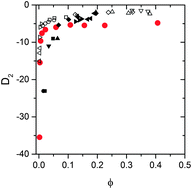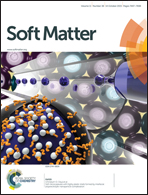Gelation of Fmoc-diphenylalanine is a first order phase transition†
Abstract
We explore the gel transition of the aromatic dipeptide derivative molecule fluorenylmethoxycarbonyl-diphenylalanine (Fmoc-FF). The addition of water to a solution of Fmoc-FF in dimethyl sulfoxide (DMSO) results in increased attractions leading to self-assembly of Fmoc-FF molecules into a space-filling fibrous network. We provide evidence that gel formation is associated with a first order phase transition resulting in nucleation and growth of strongly anisotropic crystals with high aspect ratios. The strength of attraction between Fmoc-FF molecules as a function of water concentration is estimated from long-time self-diffusion measurements using 1H NMR diffusion-ordered spectroscopy (DOSY). The resulting phase behavior follows that observed for a wide range of other crystallizing nanoparticles and small molecules – a result consistent with the short-range nature of the intermolecular attractions. Furthermore, we use NMR to measure the rate of increase in the fraction of bound Fmoc-FF molecules after water is suddenly mixed into the system. We observe a lag time in the formation of the new phase indicative of the existence of a free energy barrier to the formation of a crystal nucleus of critical size. The application of classical nucleation theory for a cylindrical nucleus indicates that one-dimensional crystal growth is driven by an imbalance of the surface energies of the ends and sides of the fiber.


 Please wait while we load your content...
Please wait while we load your content...